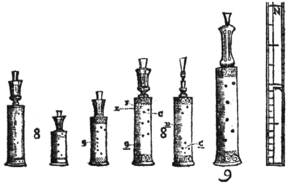Rankett

The Rankett , also Ranckett , Rackett or Rakett , is a woodwind instrument of the Renaissance and Baroque .
The renaissance anchoring

In the Renaissance anchoring, a vertical turret protrudes from a round block of pear or maple wood , on which the double reed sits vertically. Outwardly, this construction resembles the towers of the city fortifications of Seville . The cylindrical inner bore of the instrument is twisted nine times inside the instrument, so that the relatively small instruments sound in an extremely low pitch. When playing, the hands are opposite each other, and gripping is not only done with the fingertips, but also with the lower limbs.
The Renaissance anchoring is blown directly, the approach with inflated cheeks and freely swinging reed in the oral cavity or the use of wind capsules are not documented. However, a pirouette (lip support) is often used to relieve the lips . The instrument is blown horizontally, inclined slightly downwards.
The sound of the Renaissance anchoring is rougher and stronger than the dulcian or the later bassoon . Like most reed instruments of the Renaissance, Renaissance chains only have a small dynamic range, changes in the blowing pressure are primarily used for intonation.
In the 20th century, Renaissance anchors were recreated for a while, with the sizes tenor F – d 0 , basset B 1 –g 0 , bass F 1 –d 0 and large bass B 2 –G being built.
The baroque veil
The baroque anchoring differs considerably from the Renaissance anchoring. As far as the pipe end and the blow pipe are concerned, it corresponds to a bassoon that is strongly compressed by the inner bore inherited from the Renaissance anchoring. However, in contrast to the Renaissance anchoring, the inner bore is conical, whereby the cone has a very low pitch due to the design. It is noticeable that the baroque veil is blown at the other end of the tube. The “turret” now represents the end of the tube, i.e. the bell, while the blowpipe protrudes diagonally from the “handle”. The inner bore of the instrument is wound ten times inside the instrument. Because of the blowpipe, the baroque ropes can be held vertically while playing or placed on a table. The sound of the baroque vault is rougher and stronger than the baroque bassoon used at the same time. Compared to the baroque bassoon, the Rankett has a smaller range, so that (e.g. in Pepusch ) figured bass parts for the Rankett can be distinguished from those for the bassoon.
Baroque vine chains have been built again since the middle of the 20th century. The range of one of these instruments ranges from B 1 –d 1 , that is, in the range of a bassoon.
On the history of the Rankett
The origin of the Rankett is believed to be in the German-speaking area. First mentions can be found in the Württemberg inventory from 1576, a Graz inventory from 1590 recorded Rogetten . A painting by the Munich court orchestra from this period also shows a Rankett player. The change in the bass chain after 1680 is attributed to the instrument maker Johann Christoph Denner .
Both Renaissance and Baroque anchors have only a very short history. Because of the advantages described, these handy instruments may have been very popular. At Ambras Castle near Innsbruck there are even two miniature ivory vine chains . Also from Ambras Castle comes a set of five tartölts , also known as dragon bowls, dragon-shaped tendrils. The Ambras instruments are exhibited in the collection of old musical instruments in Vienna. The ivory vine chain has a very delicate sound, which Michael Praetorius describes as "very quiet, almost like blowing through a cam". At the end of the Baroque period the rankett was replaced by the bassoon, the softer sound of which was preferred during this period.
Baroque scroll chains can be found in several museums and in considerable numbers. B. in the Berlin musical instrument collection one built around 1700 by W. Wijne from Nijmegen .
literature
- William Waterhouse: Racket. In: Grove Music Online, 2001
Web links
- Rankett, Rackett, "Würstelfagott" or "Faustbagott". Heinrich Schütz House
